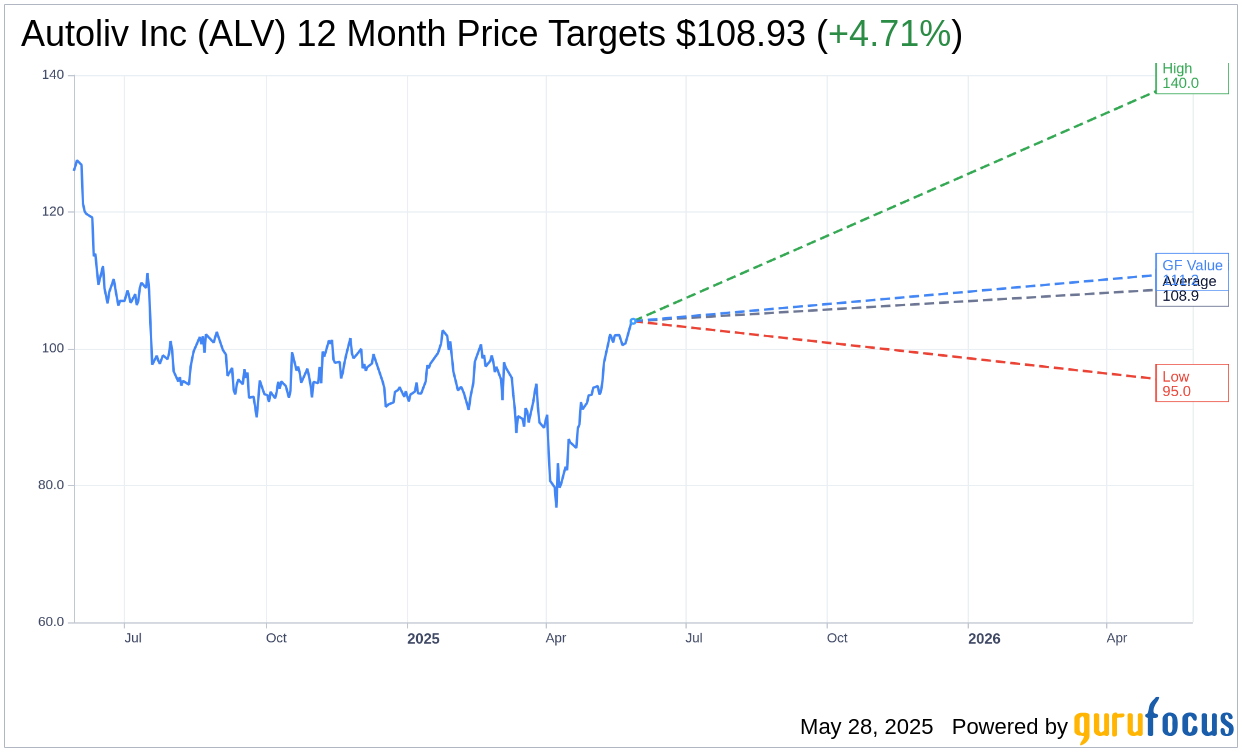UBS has increased its price target for Autoliv (ALV, Financial) from $103 to $123, maintaining a Buy rating for the stock. This adjustment comes after the company reported strong first-quarter earnings and upheld its previous guidance, suggesting a reduced impact from tariffs compared to initial expectations. The firm's analysis indicates that Autoliv's management is likely to emphasize strengthening investor confidence in the company's strategy towards sustainable growth.
Wall Street Analysts Forecast

Based on the one-year price targets offered by 18 analysts, the average target price for Autoliv Inc (ALV, Financial) is $108.93 with a high estimate of $140.00 and a low estimate of $95.00. The average target implies an upside of 4.71% from the current price of $104.03. More detailed estimate data can be found on the Autoliv Inc (ALV) Forecast page.
Based on the consensus recommendation from 21 brokerage firms, Autoliv Inc's (ALV, Financial) average brokerage recommendation is currently 2.2, indicating "Outperform" status. The rating scale ranges from 1 to 5, where 1 signifies Strong Buy, and 5 denotes Sell.
Based on GuruFocus estimates, the estimated GF Value for Autoliv Inc (ALV, Financial) in one year is $111.24, suggesting a upside of 6.93% from the current price of $104.03. GF Value is GuruFocus' estimate of the fair value that the stock should be traded at. It is calculated based on the historical multiples the stock has traded at previously, as well as past business growth and the future estimates of the business' performance. More detailed data can be found on the Autoliv Inc (ALV) Summary page.
ALV Key Business Developments
Release Date: April 16, 2025
- Net Sales: $2.6 billion, a 1% decrease year over year.
- Adjusted Operating Income: Increased by 28% to $255 million from $199 million last year.
- Adjusted Operating Margin: 9.9%, an improvement of 230 basis points from the previous year.
- Gross Margin: 18.6%, an increase of 160 basis points year over year.
- Adjusted Earnings Per Share (EPS) Diluted: Increased by $0.58, driven by higher operating income and a lower number of shares.
- Return on Capital Employed: 26%.
- Return on Equity: 29%.
- Share Buybacks: Repurchased and retired 500,000 shares for $50 million.
- Dividend: $0.70 per share.
- Operating Cash Flow: $77 million, a decrease of $45 million from the previous year.
- Free Operating Cash Flow: Negative $16 million, compared to negative $18 million in the prior year.
- Trade Working Capital: Decreased by $56 million, with improvements in accounts receivables, payables, and inventories.
- Leverage Ratio: 1.3 times, virtually flat year over year.
For the complete transcript of the earnings call, please refer to the full earnings call transcript.
Positive Points
- Autoliv Inc (ALV, Financial) outperformed global light vehicle production despite significant headwinds, particularly in China.
- The company achieved record earnings per share for the first quarter, driven by a lower number of shares and high net profit.
- Autoliv Inc (ALV) significantly improved its profit and operating margin compared to the previous year, primarily due to well-executed cost reduction activities.
- The company neutralized tariffs almost entirely in the quarter through agreements with customers.
- Autoliv Inc (ALV) continues to generate a high level of return on capital employed, supporting a high level of shareholder returns.
Negative Points
- Sales in the first quarter decreased by 1% year over year due to negative effects from currency and adverse regional and customer mix development.
- The company faces significant uncertainty in the global light vehicle production outlook for 2025, influenced by tariffs and slowing economic growth.
- Autoliv Inc (ALV) experienced an unfavorable regional light vehicle production mix, significantly impacting its outperformance negatively.
- Operating cash flow decreased by $45 million compared to the same period last year, mainly due to increased receivables.
- The company anticipates cost pressures from labor, especially in Europe and America, and potential inflationary pressure from ongoing tariff situations.
